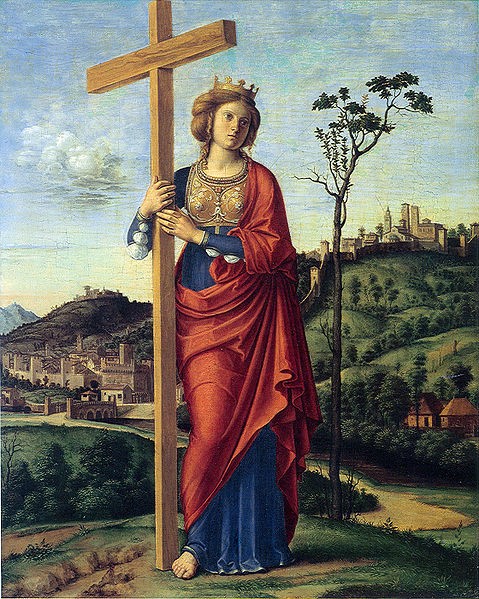This is a legend unlike any other. It all started with a young servant girl named Flavia Julia Helena.1 Born in 248 C.E. in Bithynia, a province of the Roman Empire, Helena was no different from anyone else, until the day that she caught the eye of the Roman emperor Constantius I Chlorus with her beauty.2
They married, had a son in the year 272 who, if you have ever learned anything about Roman history, you will probably know. Their son was the one and only Constantine. Constantine became one of the greatest Roman emperors. One of the things he is known for is the Edict of Milan, issued in the year 313.3 The Edict of Milan allowed for Christianity to be a freely practiced religion. It was at this time that Helena most likely converted to Christianity.4

In the year 324, Constantine sent Helena on a pilgrimage to the Holy Lands in search of the “Holy Sepulcher” and “The True Cross.” The “Holy Sepulcher” is the location of the crucifixion of Jesus Christ, while “The True Cross” is the cross on which Jesus Christ was crucified.5 On this pilgrimage, it was said that Helena “followed in the footsteps of Jesus,” by performing many acts of kindness and good works, such as giving money, food, and clothing to the poor, and also helping churches with funds as well as their other needs.6 After weeks of traveling, they finally made it to Jerusalem. With the help Judas Cyriancus, a man selected at random and forced against his will to help, Helena was able to get closer than she ever had to finding “The True Cross.”7 This is where the story diverges. Although some believe a commoner from a nearby town led Helena to “The True Cross,”others believe that it was Judas Cyriancus.
They continued their search for days, when their prayers were finally answered. Helena said it was then, “With sweet smelling dust and a flash of lighting pointed to the place where,” she instructed Judas to started digging.8 Finally, they uncovered three crosses, one thought to belong to Jesus Christ, and the others belonging to the two thieves that died alongside Him. To test and see which one of these crosses truly belonged to Jesus Christ, they searched for a leper at the outskirts of Jerusalem. Once one was found, they returned back to the site of Golgotha, the place of Jesus’ crucifixion. The leper was instructed to touch each of the crosses one by one. He touched the first one and nothing happened. He touched the second one and still nothing happened. Finally, when he touched the third and final cross, the leper was instantly healed.9 It was this cross that healed the leper, and for that reason it is known as the “The True Cross.”

The cross was then carried back to Constantinople, while part of the cross was placed in the hands of the bishop of Jerusalem.10 As the years passed, fragments of “The True Cross” were placed in the care of many Catholic churches around the world for all to admire. Although we may never know whether the cross they found and distributed was “The True Cross,” like all legends, in the end it is up to us whether to believe the account or not.
- Dictionary of World Biography, 2016 s.v. “Helena, St.” ↵
- Global Events: Milestone Events Throughout History, 2014, s.v. “Saint Helena Makes a Pilgrimage to the Holy Land,” by Jennifer Stock. ↵
- Global Events: Milestone Events Throughout History, 2014, s.v. “Saint Helena Makes a Pilgrimage to the Holy Land,” by Jennifer Stock. ↵
- Dictionary of World Biography, 2016 s.v. “Helena, St.” ↵
- New Catholic Encyclopedia, 2003 s.v. “Helena, St,” by J. H. Geiger. ↵
- Global Events: Milestone Events Throughout History, 2014, s.v. “Saint Helena Makes a Pilgrimage to the Holy Land,” by Jennifer Stock. ↵
- Barbara Baert, “New Observations on the Genesis of Girona (1050-1100). The Iconography of the Legend of the True Cross,” Gesta 38, no. 2 (1999): 117-121. ↵
- Barbara Baert, “New Observations on the Genesis of Girona (1050-1100). The Iconography of the Legend of the True Cross,” Gesta 38, no. 2 (1999): 117-121. ↵
- Barbara Baert, “New Observations on the Genesis of Girona (1050-1100). The Iconography of the Legend of the True Cross,” Gesta 38, no. 2 (1999): 117-121. ↵
- Religious Celebrations: An Encyclopedia of Holidays, Festivals, Solemn Observances, and Spiritual Commemorations, 2011, s.v. “Elevation of the True Cross (September 14),” by J. Gordon Melton. ↵



56 comments
Eliza Merrion
Religion has always been a major part of my life and I love reading about it. Your article Saint Helena was very enjoyable to read. The story about the true cross and how the leaper was healed instantly as soon as he touched the cross Christ died on, is inspiring. The church I grew up attending, Sacred Heart in Farmington, New Mexico, actually held a small splinter from the true cross on the altar. Your article was well written and I enjoyed the images you used.
Elliot Avigael
I’ve always expressed an interest in ancient religious relics, such as the Ark of The Covenant, Noah’s Ark, and the Holy Grail. It is difficult to say whether or not this is the cross that Christ was indeed crucified on, but then again, who are we to say that it wasn’t?
Patricia Hartmann
I am an Orthodox Christian, raised Roman Catholic. Everything in your account of St. Helen, and more, is well documented. So, it is not a legend. There are many relics of the true cross around the world.
Helena Fallow
I loved but there was a HUGE problem for me! It didnt tell me what her gives and verchus are Auther just tell us! Some fof us need to KNOW! And this was awesome what so ever. I ddnt need anything in it tho bai!
Micheala Whitfield
Wonderful article! I currently take a God class and I really like this article. I would love to bring this up to my teacher. What Is interesting is that she went to find a leper and it healed. I hope that one day, we invent a way to see the past and what actually happened. Everything about the Catholic religion comes from belief and from faith. It’s what we choose to believe. Without The resurrection of Jesus, there would be no Christianity. His stories come from the people who viewed, saw, and experienced his presence and their stories spread to others. Great article.
Helen Dao
This story of the Empress Helena is known by the majority of orthodox Christians! It tells us how the cross was founded and its importance in Byzantine Christianity! It would be interesting to read more about her life and the connection she had to Agia Sofia and the other two churches in Jerusalem and her involvement!
Anthony Coronado
I have seen the fictional and televised on the scientific discovery in finding the supposedly the True Cross (Cross of Jesus). I have heard of Constantine in World History as a famous Roman emperor. We didn’t get into in-depth on the parentage of rulers. This story was very interesting with the faith-based discovery of the True Cross while using the Bible reading to identify the healing powers of the True Cross
Michael Esparza
I had never actually heard the story of St. Helena, although it was a very good one. This story is good one because of the faith she had to continue and search for the cross. While there isn’t much information on to whether it was the true cross or not. The story still stands to be an important one for Catholics, not because of any historical truth but because of the story of hope and faith.
OSAMA ATA
If you want to feel the presence of the Lord, just visit the Basilica of the “Holy Cross in Jerusalem” in Rome. What a sensation in a unique timeless frame when you see the true cross, the thorns of the crown , an 6 to 8 inch primitive nail and the plaque on which INRI is written in 3 languages..Praise the Lord..
Witnessed by a n engineering scholar
Olivia Tijerina
I have never heard of a legend such as this one, and even more, there was a miracle performed along with the discovery of the cross.I am always interested in hearing about others trying to be the true reflection of Jesus and a the end they have a miracle at the end. Due to there being three and to my understanding in the location of Christ the idea will prolong. I wonder how intact those crosses were?But that is not the point, the message is that a saint named St. Helena had found the crosses out of her works and others.